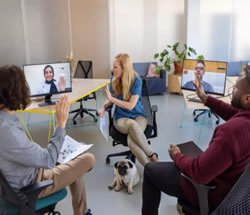Lisa Earle McLeod* believes hybrid working has a future, but in a world where work-from-home is no longer mandated, it needs careful and strategic planning.
 Did you put on real pants, fight traffic, and eat a sub-optimal lunch today just to sit in your corporate office…on a zoom call?
Did you put on real pants, fight traffic, and eat a sub-optimal lunch today just to sit in your corporate office…on a zoom call?
You’re not the only one.
We know there can be huge benefits to in-person collaboration and relationship building.
We also recognise (well, most of us) that demanding a five-day in-office work week poses a big obstacle for recruiting, engagement and retention.
Which leaves us somewhere in the murky middle.
Some of our clients have shifted to 100 per cent remote work indefinitely; others are fighting an (uphill) battle to return their teams back to the office full time.
The vast majority are somewhere in between — trying to figure out the awkwardness of a hybrid model.
It’s emblematic of a larger shift in the workplace.
Here’s what Gallup found.
When asked where they (respondents) planned to work long term — remote-capable employees confirmed that a hybrid work schedule would be the predominant office arrangement.
About 53 per cent expected a hybrid arrangement, and 24 per cent expected to work exclusively remotely.
Gallup’s recent report also revealed that six in 10 people wanted a coordinated effort around when to go into the office.
Here are three best practices I’ve seen make a difference.
Remember that all days are not created equal
Take a look at what you want to accomplish for the year.
Ask what activities depend most on collaboration? What relationships need shoring up? What do I want to be more involved with?
Of course, all these things can be done remotely, but they’re often easier in person.
Prioritising where you get the most out of your ‘face time’ brings a strategic view to your role and your schedule, against allocating your in-office days to when you have clean clothes.
Sync up when you can, even though it’s more work
Whether it’s three-days a quarter, one day a week, or somewhere in between, syncing up with colleagues, and especially your boss, will make in-person time feel more worth it.
It also minimises the awkward (on both sides) feeling of sitting in a conference room, but still telling your colleague they’re on mute.
The odds of a perfect sync-up are slim to none, but don’t let the fear of imperfection keep you from an attempt.
Re-evaluate regularly
If it’s not working, or even not working as well as you hoped, step back and reassess.
Even if it’s not your first choice, you might need more time in the office, more time at home, or a more coordinated effort.
Keep refining and recognise that your needs might change over time.
For example, a big push for an innovative project is likely going to require more in-person collaboration than the following quarter of data review.
If you’re finding yourself constantly on Zoom in your office, or constantly wishing the people in the room would remember you dialled in from home, don’t accept it as the inevitable pain of ‘working hybrid’.
Yes, this model is a work in progress — emphasis on the ‘in progress’.
In my view, a hybrid model can work, but not without deep intentionality.
Left to chance, everyone will be on Zoom in their office, eating lunch alone, and become increasingly resentful every time they fill up their car.
Taking a strategic view of your role (and team) can help you maximise the best of both worlds.
*Lisa Earle McLeod is the leadership expert best known for creating the popular business concept Noble Purpose. She is the author of Selling with Noble Purpose and Leading with Noble Purpose. She can be contacted at mcleodandmore.com.
This article first appeared at mcleodandmore.com.











